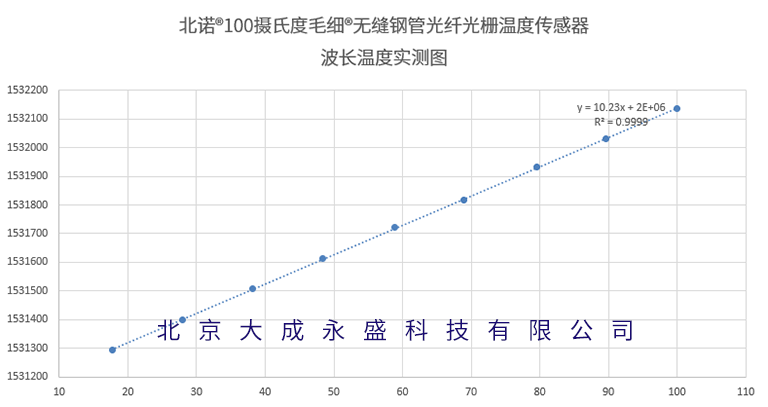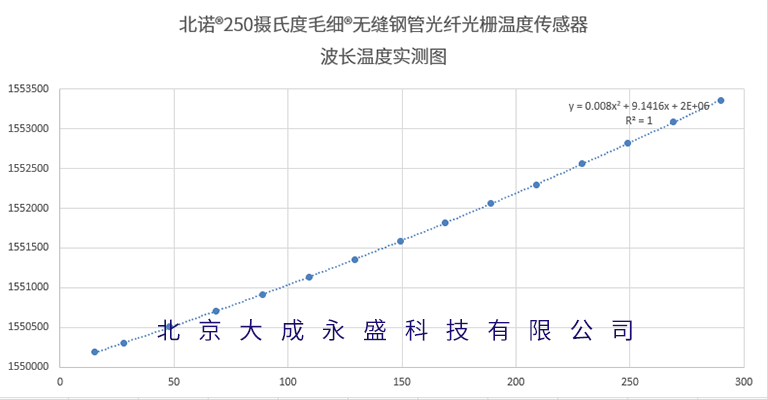This article describes a factory temperature calibration experiment conducted on OFSCN® capillary seamless steel tube fiber bragg grating (FBG) temperature sensor (FBG thermometers). The experiment aims to establish the correlation between wavelength changes and temperature variations (determining the temperature coefficient of the fiber Bragg grating temperature sensor) and provides an experimental report and error analysis.
The experiment confirms the accurate temperature measurement and high precision of OFSCN® capillary seamless steel tube fiber bragg grating (FBG) sensors produced by DCYS.
In a previous article titled "Experiment Ⅰof Fiber Bragg Grating(FBG) Temperature Sensor : Influence of Tensile Force, Stress, and Strain on FBG Thermometer," we demonstrated through experiments that the fiber Bragg grating (FBG) in the innovative OFSCN® capillary seamless steel tube fiber bragg grating (FBG) sensor (FBG thermometer) remains in a free state axially and is not affected by external tensile stress.
This finding indirectly proves that the temperature variation does not affect the OFSCN® capillary seamless steel tube fiber bragg grating (FBG) sensors (FBG thermometers) produced by DCYS. due to the different coefficients of thermal expansion between stainless steel and glass fiber. This is because, for the FBG, the tensile stress caused by thermal expansion is of the same nature as the externally applied tensile stress on the fiber Bragg grating (FBG). They are both external forces.
Therefore, we have more reason to believe that the temperature measurement accuracy and precision of OFSCN® capillary seamless steel tube fiber bragg grating (FBG) sensors (FBG thermometers) produced by DCYS. To prove this point, we are now starting the second experiment: temperature coefficient calibration of fiber Bragg grating temperature sensors. This calibration experiment is a necessary procedure for all OFSCN® capillary Seamless Steel Tube Fiber Bragg Grating (FBG) temperature sensors (FBG thermometers) before leaving the factory.
 |
|
Figure 1 |
|
|
| Figure 2 |
Ⅰ. Experiment Objective
To verify the accurate temperature measurement and high precision of OFSCN® capillary seamless steel tube fiber bragg grating (FBG) sensors produced by DCYS and to confirm the temperature coefficient of the fiber Bragg grating temperature sensors through calibration.
Ⅱ. Experimental Equipment
Fiber Bragg grating demodulator, OFSCN® capillary seamless steel tube fiber bragg grating (FBG) sensor (FBG thermometer), temperature-controlled chamber with a resolution of 0.1 degrees Celsius.
Ⅲ. Experimental Method
In this experiment, an OFSCN® Capillary Seamless Steel Tube Fiber Bragg Grating temperature sensor (FBG thermometer) was connected to a fiber Bragg grating demodulator, and the sensing part of the sensor was placed in the temperature-controlled chamber. The temperature-controlled chamber had a resolution of 0.1°C. At different temperatures, the wavelength of the fiber Bragg grating (FBG) in the FBG thermometer was read using the fiber Bragg grating demodulator, and the experiment was completed after comparison.
Ⅳ. Experimental Procedure and Data Analysis
To achieve better temperature control and reduce temperature disturbances in the temperature-controlled chamber, we used a stepwise heating method to test the OFSCN® Capillary Seamless Steel Tube Fiber Bragg Grating temperature sensor.
After fixing the OFSCN® Capillary Seamless Steel Tube Fiber Bragg Grating temperature sensor (FBG) with a fixture, we gradually increased the temperature in the temperature-controlled chamber from room temperature. We recorded the wavelength of the fiber Bragg grating (FBG) corresponding to each temperature at approximately every 10 degrees Celsius, up to 100°C.
The complete set of experimental data analysis is shown in Figure 3.
 |
|
Figure 3 |
Ⅴ. Experimental Conclusion
Based on the above experimental data, it can be concluded that OFSCN® Capillary Seamless Steel Tube fiber Bragg grating temperature sensors produced by DCYS provide accurate temperature measurement with high precision, and the temperature coefficient calibration shows good linearity.
Ⅵ. Further Explanation
The packaging structure of OFSCN® Capillary Seamless Steel Tube Fiber Bragg Grating temperature sensor is essentially a protective encapsulation. With the fiber Bragg grating (FBG) always in a free state axially, the encapsulation structure neither increases nor decreases sensitivity, but accurately reflects the state of the fiber Bragg grating, with a temperature measurement accuracy (sensor resolution) of 0.1 degrees Celsius.
Therefore, the accuracy of temperature measurement for OFSCN® Capillary Seamless Steel Tube Fiber Bragg Grating temperature sensors is more related to the characteristics of the fiber Bragg grating used in the sensors.
Based on our current testing, fiber Bragg gratings (FBG) produced by different companies exhibit different characteristics, and they demonstrate different behavior at different temperatures. However, overall, their linearity is acceptable (using polynomial fitting), as shown in Figure 4.
In the test shown in Figure 4, OFSCN® Capillary Seamless Steel Tube Fiber Bragg Grating temperature sensor (FBG thermometer) was used for temperature detection at 250 degrees Celsius, demonstrating accurate and highly precise temperature measurement.
 |
|
Figure 4 |
Our philosophy is: "OFSCN®, make optical fiber stronger!"

